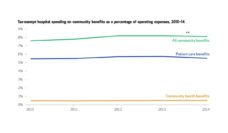On November 6th, Massachusetts voters will decide on three ballot measures. Question 1 asks about establishing mandated patient assignment limits for registered nurses working in hospitals. If enacted, hospitals would need to have one to six registered nurses per patient based on the type of unit. In 2014, Massachusetts legislation enacted a similar law that requires one or two registered nurses per patient in the intensive care unit based on a patient acuity tool. Voters will have to decide whether a similar set of criteria for minimum staffing requirements should be expanded to all other inpatient units of a hospital.
Support for Minimum Staffing Limits
A primary argument in favor of the proposal is that it would reduce the workload of nurses, which may allow nurses to spend more time with patients and potentially improve care outcomes. A large body of research has shown that greater staffing levels are associated with lower rates of hospital-acquired infections, readmission rates, mortality rates, and better cardiac arrest survival. The ballot initiative has widespread support among nurses who say that patients they care for now are in worse health compared to ten years ago. Nurses also feel they have less time to spend preparing and educating patients for their discharge and explaining new medications.
When considering how the change may influence care, it is helpful to look to California as an example. In 1999, the state passed a law requiring minimum nurse-to-patient staffing ratios. Hospitals appeared able to meet these goals without reductions in the overall skill mix among nurses. One estimate suggests the cost of implementing the law would range between $36 to $47 million, making it a relatively low-cost, high-benefit proposal.
Reasons Against Minimum Staffing Limits
An argument against minimum staff levels is that patient-centered care may be compromised, resulting in less autonomy in decision-making for staffing. The law, if passed, would require approximately 10,000 new nurses to be hired by January 1, 2019. This would be a challenge and raises the question of just how hospitals would find qualified nurses in less than two months. Two recent cost estimate studies showed the law would have a substantially large increase in cost of care ($676 to 949 million annually). The cost is significantly higher than the potential for savings ($34 to 47 million annually) and could inflate to 1.3 billion in the first year.
While hospitals in California met the staffing goals, this may have been due to hospital and bed section closures. Given the penalty of $25,000 per day for Massachusetts hospitals not meeting staffing requirements, hospitals may opt to close units that cannot be sufficiently staffed. The changes are estimated to hit behavioral health care especially hard, with a possible loss of 1,000 beds. Further, wait times in the emergency department greatly increased in California due to nurses being “called-in” to staff units before new patients could be admitted. Research has shown higher staffing levels associated with better care, but, when California enacted the law, quality of care and patient safety indicators did not change. Likewise, improvement in mortality or complication rates were not seen when Massachusetts implemented mandatory staffing requirements of the intensive care units in 2016.
An important choice
While voters will make many important decisions this upcoming election day, it is important to consider what the future of hospital services in the state may look like in the coming years. The headlines may present Question 1 as a simple choice between nurses caring for patients pitted against hospital profits, but the question is complex with conflicting findings for both sides.
Feature image: foto-ruhrgebiet/iStock













